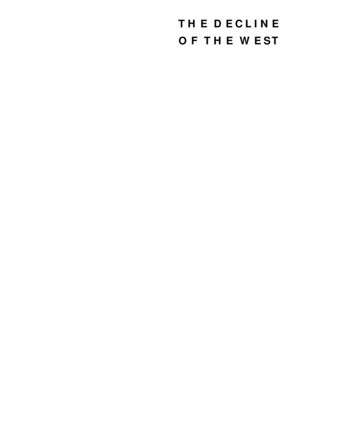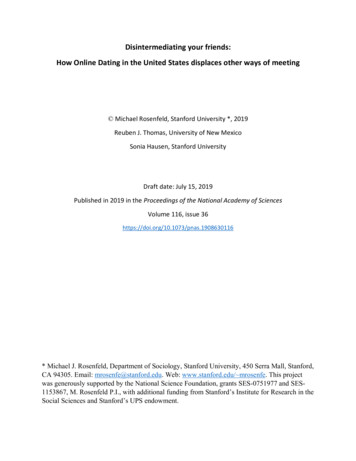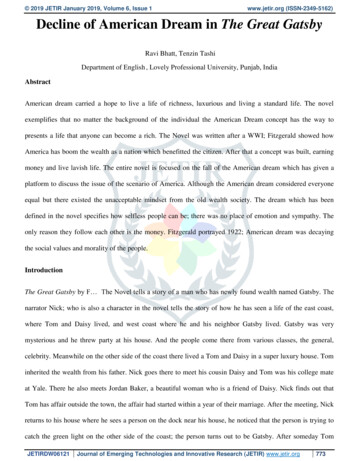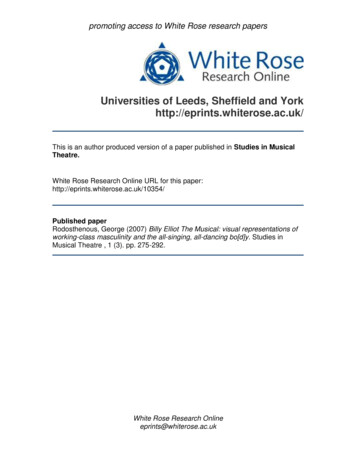
Transcription
THE DECLINEOF THE WEST
THE DECLINEO F T H E W E S TFORM AND ACTUALITYBYOSWALD SPENGLERAUTHORIZED TRANSLATIONWITH NOTES BYCHARLES FRANCIS ATKINSONMCMXXVII:ALFRED A KNOPF:NEW YORK
COPYRIGHT 1916, BY ALFRED A. KNOPF, INC.PUBLISHED, APRIL, I926SECOND PRINTING, APRIL, I926THIRD PRINTING, JULY, 1926FOURTH PRINTING, NOVEMBER, 192.6FIFTH PRINTING, DECEMBER, 1926SIXTH PRINTING, MAY, I92.7MANUFACTURED IN THE UNITED STATES OF AMERICA
THIS TRANSLATION ISDEDICATED TOELLINOR JAMESA FRIEND
Wenn im Unendlichen dasselbeSich wiederholend ewig flies st,Das tausendfältige GewölbeSich kräftig ineinander schliesst;Strömt Lebenslust aus allen Dingen,Dem kleinsten wie dem grossten Stern,Und alles Drängen, alles RingenIst ewige Ruh in Gott dem Herrn.— Goethe.
TRANSLATOR’S PREFACEmust be left to critics to say whether it was Destiny or Incident — usingthese words in the author’s sense — that Spengler’s “Untergang des Abendlandes” appeared in July, 1918, that is, at the very turning-point of the fouryears’ World-War. It was conceived, the author tells us, before 1914 and fullyworked out by 1917. So far as he is concerned, then, the impulse to create itarose from a view of our civilization not as the late war left it, but (as he saysexpressly) as the coming war would find it. But inevitably the public impulseto read it arose in and from post-war conditions, and thus it happened that thissevere and difficult philosophy of history found a market that has justified theprinting of 90,000 copies. Its very title was so apposite to the moment as topredispose the higher intellectuals to regard it as a work of the moment — themore so as the author was a simple Oberlehrer and unknown to the world ofauthoritative learning.Spengler’s was not the only, nor indeed the most “popular,” philosophicalproduct of the German revolution. In the graver conjunctures, sound minds donot dally with the graver questions — they either face and attack them withsupernormal resolution or thrust them out of sight with an equally supernormaleffort to enjoy or to endure the day as it comes. Even after the return to normal ity, it is no longer possible for men — at any rate for Western men — not toknow that these questions exist. And, if it is none too easy even for the victorsof the struggle to shake off its sequelae, to turn back to business as the normaland to give no more than amateur effort and dilettantish attention to the verydeep things, for the defeated side this is impossible. It goes through a period ofmaterial difficulty (often extreme difficulty) and one in which pride of achieve ment and humility in the presence of unsuccess work dynamically together. Soit was with sound minds in the post-Jena Germany of Jahn and Fichte, and so itwas also with such minds in the Germany of 1919-1910.To assume the r&le of critic and to compare Spengler’s with other philoso phies of the present phase of Germany, as to respective intrinsic weights, is notthe purpose of this note nor within the competence of its writer. On the otherhand, it is unconditionally necessary for the reader to realize that the book beforehim has not only acquired this large following amongst thoughtful laymen, buthas forced the attention and taxed the scholarship of every branch of the learnedworld. Theologians, historians, scientists, art critics — all saw the challenge,Itix
XTRANSLATOR'S PREFACEand each brought his apparatus criticus to bear on that part of the Spenglertheory that affected his own domain. The reader who is familiar with Germanmay be referred to Manfred Schroeter’s "Der Streit um Spengler" for details;it will suffice here to say that Schroeter’s index of critics’ names contains some400 entries. These critics are not only, or even principally, general reviewers,most of them being specialists of high standing. It is, to say the least, remark able that a volcanically assertive philosophy of history, visibly popular andproduced under a catchy title (Reklamtitel) should call forth, as it did, a specialnumber of Logos in which the Olympians of scholarship passed judgment onevery inaccuracy or unsupported statement that they could detect. (These werein fact numerous in the first edition and the author has corrected or modifiedthem in detail in the new edition, from which this translation has been done.But it should be emphasized that the author has not, in this second edition,receded in any essentials from the standpoint taken up in the first.)The conspicuous features in this first burst of criticism were, on the one hand,want of adequate critical equipment in the general critic, and, on the other, in ability to see the wood for the trees in the man of learning. No one, readingSchroeter’s book (which by the way is one-third as large as Spengler’s firstvolume itself), can fail to agree with his judgment that notwithstandingparadoxes, overstrainings, and inaccuracies, the work towers above all its com mentators. And it was doubtless a sense of this greatness that led many scholars— amongst them some of the very high — to avoid expressing opinions on itat all. It would be foolish to call their silence a "sitting on the fence’’; it is acase rather of reserving judgment on a philosophy and a methodology thatchallenge all the canons and carry with them immense implications. For thevery few who combine all the necessary depth of learning with all the necessaryfreedom and breadth of outlook, it will not be the accuracy or inaccuracy ofdetails under a close magnifying-glass that will be decisive. The very idea ofaccuracy and inaccuracy presupposes the selection or acceptance of co-ordinatesof reference, and therefore the selection or acceptance of a standpoint as "ori gin.** That is mere elementary science — and yet the scholar-critic would bethe first to claim the merit of scientific rigour for his criticisms! It is, in historyas in science, impossible to draw a curve through a mass of plotted observationswhen they are looked at closely and almost individually.Criticism of quite another and a higher order may be seen in Dr. EduardMeyer’s article on Spengler in the Deutsche Liter atur%eitung, No. 15 of 1924. Herewe find, in one of the great figures of modem scholarship, exactly that largeminded judgment that, while noting minor errors — and visibly attachinglittle importance to them — deals with the Spengler thesis fairly and squarelyon the grand issues alone. Dr. Meyer differs from Spengler on many seriousquestions, of which perhaps the most important is that of the scope and originof the Magian Culture. But instead of cataloguing the errors that are still to be
TRANSLATOR’S PREFACExifound in Spengler’s vast ordered multitude of facts, Eduard Meyer honourablybears testimony to our author’s ‘‘ erstaunlich umfangreiches, ihm standigprdsentes, Wissen” (a phrase as neat and as untranslatable as Goethe’s “exaktesinnliche Phantasie”). He insists upon the fruitfulness of certain of Spengler’sideas such as that of the “Second Religiousness.** Above all, he adheres to andcovers with his high authority the basic idea of the parallelism of organicallyliving Cultures. It is not necessarily Spengler’s structure of the Cultures that heaccepts — parts of it indeed he definitely rejects as wrong or insufficiently es tablished by evidences — but on the question of their being an organic structureof the Cultures, a morphology of History, he ranges himself frankly by the sideof the younger thinker, whose work he sums up as a “bleibendez und auf langeZeit hinaus nachhaltig wirkendez Besitz unserer Wissenschaft und Literatur.**This last phrase of Dr. Meyer’s expresses very directly and simply that whichfor an all-round student (as distinct from an erudite specialist) constitutes thepeculiar quality of Spengler’s work. Its influence is far deeper and subtler thanany to which the conventional adjective “suggestive** could be applied. Itcannot in fact be described by adjectives at all, but only denoted or adumbratedby its result, which is that, after studying and mastering it, 4 4 one finds it nearlyif not quite impossible to approach any culture-problem — old or new, dog matic or artistic, political or scientific — without conceiving it primarily as* morphological.* **The work comprises two volumes — under the respective sub-titles “Formand Reality** and 44World-historical Perspectives’*—of which the presenttranslation covers the first only. Some day I hope to have the opportunity ofcompleting a task which becomes — such is the nature of this book — moreattractive in proportion to its difficulty. References to Volume II are, for thepresent, necessarily to the pages of the German original; if, as is hoped, thistranslation is completed later by the issue of the second volume, a list of thenecessary adjustments of page references will be issued with it. The reader willnotice that translator’s foot-notes are scattered fairly freely over the pages ofthis edition. In most cases these have no pretensions to being critical annota tions. They are merely meant to help the reader to follow up in more detail thepoints of fact which Spengler, with his “standig prasentes Wissen,*’ sweepsalong in his course. This being their object, they take the form, in the majorityof cases, of references to appropriate articles in the Encyclopaedia Britannica,which is the only single work that both contains reasonably full informationon the varied (and often abstruse) matters alluded to, and is likely to be acces sible wherever this book may penetrate. Every reader no doubt will find thesenotes, where they appertain to his own special subject, trivial and even annoy ing, but it is thought that, for example, an explanation of the mathematicalLimit may be helpful to a student who knows all about the Katharsis in Greekdrama, and vice versa.
xiiTRANSLATOR’S PREFACEIn conclusion I cannot omit to put on record the part that my wife, HannahWaller Atkinson, has taken in the work of translation and editing. I may bestdescribe it by saying that it ought perhaps to have been recorded on the titlepage instead of in this place.C. F. A.January, 1926,
PREFACE TO THE REVISED EDITIONAt the close of an undertaking which, from the first brief sketch to the finalshaping of a complete work of quite unforeseen dimensions, has spread itselfover ten years, it will not be out of place to glance back at what I intended andwhat I have achieved, my standpoint then and my standpoint to-day.In the Introduction to the 1918 edition — inwardly and outwardly a frag ment — I stated my conviction that an idea had now been irrefutably formu lated which no one would oppose, once the idea had been put into words. Iought to have said: once that idea had been understood. And for that we mustlook — as I more and more realize — not only in this instance but in the wholehistory of thought — to the new generation that is bom with the ability todo it.I added that this must be considered as a first attempt, loaded with all thecustomary faults, incomplete and not without inward opposition. The remarkwas not taken anything like as seriously as it was intended. Those who havelooked searchingly into the hypotheses of living thought will know that it isnot given to us to gain insight into the fundamental principles of existencewithout conflicting emotions. A thinker is a person whose part it is to sym bolize time according to his vision and understanding. He has no choice; hethinks as he has to think. Truth in the long run is to him the picture of theworld which was bom at his birth. It is that which he does not invent butrather discovers within himself. It is himself over again: his being expressedin words; the meaning of his personality formed into a doctrine which so faras concerns his life is unalterable, because truth and his life are identical. Thissymbolism is the one essential, the vessel and the expression of human history.The learned philosophical works that arise out of it are superfluous and onlyserve to swell the bulk of a professional literature.I can then call the essence of what I have discovered “true” — that is, truefor me, and as I believe, true for the leading minds of the coming time; not truein itself as dissociated from the conditions imposed by blood and by history, forthat is impossible. But what I wrote in the storm and stress of those years was,it must be admitted, a very imperfect statement of what stood clearly beforeme, and it remained to devote the years that followed to the task of correlatingfacts and finding means of expression which should enable me to present myidea in the most forcible form.To perfect that form would be impossible — life itself is only fulfilled indeath. But I have once more made the attempt to bring up even the earliestxiii
xivPREFACETOTHEREVISEDEDITIONportions of the work to the level of definiteness with which I now feel able tospeak; and with that I take leave of this book with its hopes and disappoint ments, its merits and its faults.The result has in the meantime justified itself as far as I myself am concernedand — judging by the effect that it is slowly beginning to exercise upon ex tensive fields of learning — as far as others are concerned also. Let no one ex pect to find everything set forth here. It is but one side of what I see before me,a new outlook on history and the philosophy of destiny — the first indeed of itskind. It is intuitive and depictive through and through, written in a languagewhich seeks to present objects and relations illustratively instead of offeringan army of ranked concepts. It addresses itself solely to readers who are capableof living themselves into the word-sounds and pictures as they read. Difficultthis undoubtedly is, particularly as our awe in face of mystery — the respectthat Goethe felt — denies us the satisfaction of thinking that dissections arethe same as penetrations.Of course, the cry of “pessimism” was raised at once by those who liveeternally in yesterday (Ewiggestrigen) and greet every idea that is intended forthe pathfinder of to-morrow only. But I have not written for people whoimagine that delving for the springs of action is the same as action itself; thosewho make definitions do not know destiny.By understanding the world I mean being equal to the world. It is the hardreality of living that is the essential, not the concept of life, that the ostrichphilosophy of idealism propounds. Those who refuse to be bluffed by enuncia tions will not regard this as pessimism; and the rest do not matter. For thebenefit of serious readers who are seeking a glimpse at life and not a definition,I have — in view of the far too great concentration of the text — mentionedin my notes a number of works which will carry that glance into more distantrealms of knowledge.And now, finally, I feel urged to name once more those to whom I owepractically everything: Goethe and Nietzsche. Goethe gave me method,Nietzsche the questioning faculty — and if I were asked to find a formula formy relation to the latter I should say that I had made of his “outlook” (Ausblick) an “overlook” (Uberblick). But Goethe was, without knowing it, adisciple of Leibniz in his whole mode of thought. And, therefore, that whichhas at last (and to my own astonishment) taken shape in my hands I am ableto regard and, despite the misery and disgust of these years, proud to call aGerman -philoso-phy.Oswald Spengler.Blankenburg am Harz,December, 1922.
PREFACE TO THE FIRST EDITIONThe complete manuscript of this book — the outcome of three years* work— was ready when the Great War broke out. By the spring of 1917 it hadbeen worked over again and — in certain details — supplemented and clearedup, but its appearance in print was still delayed by the conditions then pre vailing.Although a philosophy of history is its scope and subject, it possesses also acertain deeper significance as a commentary on the great epochal moment ofwhich the portents were visible when the leading ideas were being formed.The title, which had been decided upon in 1911, expresses quite literally theintention of the book, which was to describe, in the light of the decline of theClassical age, one world-historical phase of several centuries upon which weourselves are now entering.Events have justified much and refuted nothing. It became clear that theseideas must necessarily be brought forward at just this moment and in Germany,and, more, that the war itself was an element in the premisses from which thenew world-picture could be made precise.For I am convinced that it is not merely a question of writing one out ofseveral possible and merely logically justifiable philosophies, but of writing thephilosophy of our time, one that is to some extent a natural philosophy and isdimly presaged by all. This may be said without presumption; for an idea thatis historically essential — that does not occur within an epoch but itself makesthat epoch — is only in a limited sense the property of him to whose lot itfalls to parent it. It belongs to our time as a whole and influences all thinkers,without their knowing it; it is but the accidental, private attitude towards it(without which no philosophy can exist) that — with its faults and its merits— is the destiny and the happiness of the individual.Oswald Spengler.Munich,December, igrj.XV
CONTENTSIXTranslator's NoteAuthor’s Preface to the Revised EditionXlllAuthor’s Preface to the First EditionxviChapter I. IntroductionScope of the work; p. 3. Morphology of World-History, a new philosophy, p. 5. For whomis History? p. 8. Classical and Indian mankind ahistorical, p. 9. The Egyptian mummy andthe burning of the dead, p. 13. The conventional scheme of World-History (ancient, mediaeval,modem), p. 15. Its origin, p. 18. Its breakdown, p. 12. Europe not a centre of gravity, p. 2.3.The only historical method is Goethe’s, p. 2.5. Ourselves and the Romans, p. 2.6. Nietzscheand Mommsen, p. 2.8. The problem of Civilization, p. 31. Imperialism the last phase, p. 36.The necessity and range of our basic idea, p. 39. Its relation to present-day philosophy, p. 41.Philosophy’s last task, p. 45. The origin of this work, p. 46 .Chapter II. The Meaning of Numbers51Fundamental notions, p. 53. Numbers as the sign of delimitation, p. 56. Every Culture hasits own Mathematic, p. 59. Number as magnitude in the Classical world, p. 64. Aristarchus,p. 68. Diophantus and Arabian number, p. 71. Number as Function in the Western Culture,p. 74. World-fear and world-longing, p. 78. Geometry and arithemetic, p. 81. The Limitidea, p. 86. Visual limits transcended; symbolical space worlds, p. 86. Final possibilities, p. 87.Chapter III. The Problem of World-history. (i) Physiognomic andSystematic91Copemican methods, p. 93. History and Nature, p. 94. Form and Law, p. 97. Physiognomicand Systematic, p. 100. Cultures as organisms, p. 104. Inner form, tempo, duration, p. 108.Homology, p. 111. What is meant by “contemporary,” p. 112.Chapter IV. The Problem of World-history. (2.) The Destiny-idea andTHE CaUSALITY-PRINCIPLE115Logic, organic and inorganic, p. 117. Time and Destiny, p. 119. Space and Causality, p. 119.The problem of Time, p. 12.1. Time a counter-conception to Space, p. 12.6. The symbols ofTime — tragedy, time reckoning, disposal of the dead, p. 130. Care (sex, the State, worlds),p. 136. Destiny and Incident, p. 139. Incident and Cause, p. 141. Incident and Style of exist ence, p. 141. Anonymous and personal epochs, p. 148. Direction into the future and Image ofthe Past, p. 152. Is there a Science of History? p. 155. The new enunciation of the problem,p. 159.Chapter V. Makrokosmos. (i) The Symbolism of the World-picture andtheProblem of Space161The Macrocosm as the sum total of symbols referred to a Soul, p. 163. Space and Death, p.165. “Alles vergangliche ist nur ein Gleichnis,” p. 167. The space problem (only Depth isspace-forming), p. 169. Depth as Time, p. 171. The world-idea of a Culture born out of itsprime symbol, p. 174. Classical Body, Magian Cavern, Western Infinity, p. 174.XVll
xviiiCONTENTSChapter VI. Makrokosmos. (2.) Apollinian, Faustian, and Magian181SoulPrime symbol, architecture, divinities, p. 183. The Egyptian prime symbol of the path, p.188. Expression-language of art: Ornamentation and Imitation, p. 191. Ornament and earlyarchitecture, p. 196. The window, p. 199. The grand style, p. 2.00. The history of a Style asorganism, p. 105. On the history of the Arabian style, p. 2.07. Psychology of art-technique,p. 114.Chapter VII.Music and Plastic, (i) The Arts of Form2.17Music one of the arts of form, p. 119. Classification of the arts impossible except from thehistorical standpoint, p. 22.1. The choice of particular arts itself an expression-means of thehigher order, p. 22.1. Apollinian and Faustian art-groups, p. 224. The stages of Western Music,p. 12.6. The Renaissance an anti-Gothic and anti-musical movement, p. 232. Character of theBaroque, p. 236. The Park, p. 240. Symbolism of colours, p. 245. Colours of the Near and ofthe Distance, p. 246. Gold background and Rembrandt brown, p. 247. Patina, p. 253.Chapter VIIL Music amd Plastic. (2.) Act and Portrait157Kinds of human representation, p. 259. Portraiture, Contrition, Syntax, p. 261. The heads ofClassical statuary, p. 264. Portrayal of children and women, p. 266. Hellenistic portraiture,p. 269. The Baroque portrait, p. 272. Leonardo, Raphael and Michelangelo overcome theRenaissance, p. 273. Victory of Instrumental Music over Oil-Painting, corresponding to thevictory of Statuary over Fresco in the Classical, p. 282. Impressionism, p. 285. Pergamum andBayreuth, p. 291. The finale of Art, p. 293.Chapter IX. Soul-image and Life-feeling, (i) On the Form of the2.97SoulSoul-image as function of World-image, p. 299. Psychology of a counter-physics, p. 302.Apollinian, Magian and Faustian soul-image, p. 305. The ** Will ” in Gothic space, p. 308. The” inner” mythology, p. 312. Will and Character, p. 314. Classical posture tragedy and Faustiancharacter tragedy, p. 317. Symbolism of the drama-image, p. 320. Day and Night Art, p. 324.Popular and esoteric, p. 326. The astronomical image, 329. The geographical horizon, p. 332.Chapter X. Soul-image and Life-feeling. (2.) Buddhism, Stoicism, andSocialism339The Faustian morale purely dynamic, p. 341. Every Culture has a form of morale proper toitself, p. 345. Posture-morale and will-morale, p. 347. Buddha, Socrates, Rousseau as protago nists of the dawning Civilizations, p. 351. Tragic and plebeian morale, p. 354. Return toNature, Irreligion, Nihilism, p. 356. Ethical Socialism, p. 361. Similarity of structure in thephilosophical history of every Culture, p. 364. The Civilized philosophy of the West, p. 365.Chapter XI. Faustian and Apollinian Nature-knowledge375Theory as Myth, p. 377. Every Natural Science depends upon a preceding Religion, p. 391.Statics, Alchemy, Dynamics as the theories of three Cultures, p. 382. The Atomic theory, p. 384.The problem of motion insoluble, p. 388. The style of causal process and experience, p. 391.The feeling of God and the knowing of Nature, p. 392. The great Myth, p. 394. Classical,Magian and Faustian numina, p. 397. Atheism, p. 408. Faustian physics as a dogma of force,p. 411. Limits of its theoretical (as distinct from its technical) development, p. 417. Self destruction of Dynamics, and invasion of historical ideas; theory dissolves into a system ofmorphological relationships, p. 420.Index42.3Tables Illustrating the Comparative Morphology of HistoryAtend of volume
CHAPTER IINTRODUCTION
CHAPTER IINTRODUCTIONithis book is attempted for the first time the venture of predetermining his tory, of following the still untravelled stages in the destiny of a Culture, andspecifically of the only Culture of our time and on our planet which is actu ally in the phase of fulfilment — the West-European-American.Hitherto the possibility of solving a problem so far-reaching has evidentlynever been envisaged, and even if it had been so, the means of dealing with itwere either altogether unsuspected or, at best, inadequately used.Is there a logic of history? Is there, beyond all the casual and incalculableelements of the separate events, something that we may call a metaphysicalstructure of historic humanity, something that is essentially independent ofthe outward forms — social, spiritual and political — which we see so clearly?Are not these actualities indeed secondary or derived from that something?Does world-history present to the seeing eye certain grand traits, again andagain, with sufficient constancy to justify certain conclusions? And if so, whatare the limits to which reasoning from such premisses may be pushed?Is it possible to find in life itself — for human history is the sum of mightylife-courses which already have had to be endowed with ego and personality,in customary thought and expression, by predicating entities of a higher orderlike “the Classical” or “the Chinese Culture,” “Modern Civilization” —aseries of stages which must be traversed, and traversed moreover in an orderedand obligatory sequence? For everything organic the notions of birth, death,youth, age, lifetime are fundamentals — may not these notions, in this spherealso, possess a rigorous meaning which no one has as yet extracted? In short,is all history founded upon general biographic archetypes?The decline of the West, which at first sight may appear, like the corre sponding decline of the Classical Culture, a phenomenon limited in time andspace, we now perceive to be a philosophical problem, that, when compre hended in all its gravity, includes within itself every great question ofBeing.If therefore we are to discover in what form the destiny of the WesternCulture will be accomplished, we must first be clear as to what culture is, whatits relations are to visible history, to life, to soul, to nature, to intellect, whatthe forms of its manifestation are and how far these forms — peoples, tonguesIn
4THE D E C L I N E O F T H E W E S Tand epochs, battles and ideas, states and gods, arts and craft-works, sciences,laws, economic types and world-ideas, great men and great events — may beaccepted and pointed to as symbols.iiThe means whereby to identify dead forms is Mathematical Law. Themeans whereby to understand living forms is Analogy. By these means weare enabled to distinguish polarity and periodicity in the world.It is, and has always been, a matter of knowledge that the expression-formsof world-history are limited in number, and that eras, epochs, situations,persons are ever repeating themselves true to type. Napoleon has hardly everbeen discussed without a side-glance at Csesar and Alexander — analogies ofwhich, as we shall see, the first is morphologically quite inacceptable and thesecond is correct — while Napoleon himself conceived of his situation as akinto Charlemagne’s. The French Revolutionary Convention spoke of Carthagewhen it meant England, and the Jacobins styled themselves Romans. Othersuch comparisons, of all degrees of soundness and unsoundness, are those ofFlorence with Athens, Buddha with Christ, primitive Christianity withmodern Socialism, the Roman financial magnate of Csesar’s time with theYankee. Petrarch, the first passionate archaeologist (and is not archaeology it self an expression of the sense that history is repetition?) related himself men tally to Cicero, and but lately Cecil Rhodes, the organizer of British SouthAfrica, who had in his library specially prepared translations of the classicallives of the Caesars, felt himself akin to the Emperor Hadrian. The fatedCharles XII of Sweden used to carry Quintus Curtius’s life of Alexander in hispocket, and to copy that conqueror was his deliberate purpose.Frederick the Great, in his political writings — such as his Considerations,173 8 — moves among analogies with perfect assurance. Thus he comparesthe French to the Macedonians under Philip and the Germans to the Greeks.‘‘Even now,” he says, “the Thermopylae of Germany, Alsace and Lorraine,are in the hands of Philip,” therein exactly characterizing the policy of Car dinal Fleury. We find him drawing parallels also between the policies of theHouses of Habsburg and Bourbon and the proscriptions of Antony and ofOctavius.Still, all this was only fragmentary and arbitrary, and usually implied rathera momentary inclination to poetical or ingenious expressions than a really deepsense of historical forms.Thus in the case of Ranke, a master of artistic analogy, we find that hisparallels of Cyaxares and Henry the Fowler, of the inroads of the Cimmeriansand those of the Hungarians, possess morphologically no significance, and hisoft-quoted analogy between the Hellenic city-states and the Renaissancerepublics very little, while the deeper truth in his comparison of Alcibiades
INTRODUCTION5and Napoleon is accidental. Unlike the strict mathematician, who finds innerrelationships between two groups of differential equations where the laymansees nothing but dissimilarities of outward form, Ranke and others draw theirhistorical analogies with a Plutarchian, popular-romantic, touch, and aimmerely at presenting comparable scenes on the world-stage.It is easy to see that, at bottom, it is neither a principle nor a sense of his toric necessity, but simple inclination, that governs the choice of the tableaux.From any technique of analogies we are far distant. They throng up (to-day morethan ever) without scheme or unities, and if they do hit upon something whichis true — in the essential sense of the word that remains to be determined —it is thanks to luck, more rarely to instinct, never to a principle. In this re gion no one hitherto has set himself to work out a method, nor has had theslightest inkling that there is here a root, in fact the only root, from whichcan come a broad solution of the problems of History.Analogies, in so far as they laid bare the organic structure of history, might
years’ World-War. It was conceived, the author tells us, before 1914 and fully worked out by 1917. So far as he is concerned, then, the impulse to create it arose from a view of our civilization not as the late war left it, but (as he says expre










